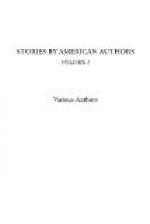“But what I’m after telling you isn’t the singular part of it at all,” resumed Megilp, taking some silver from his pocket and evidently settling down to the subject. “What is ten years to it? According to the mint reports a coin of the precious metals loses by wear and tear but one twenty-four hundredth of its bulk in a year. These pieces I hold in my hand, coined forty years ago, are scarcely defaced. In another forty they will be hardly more so. What, for instance, has been the career of this Mexican dollar? Perhaps it was struck from bullion fresh from a Mexican mine. In that case I have nothing to say. But just as likely it was struck from old Spanish plate or from former coin, and then it takes us back to the earliest times, and its origin is lost in obscurity. The same metal is time after time re-melted, re-cast, re-stamped, and thus maintained in perpetual youth. This gold piece upon my watch-chain was perchance coined from the sands of the Pactolus, and once bore Chaldaean characters. And to what uses has it come?
’Imperial Caesar, dead and
turned to clay,
Might stop a hole to keep the wind
away;’
and so the pieces paid for the ransom of the Inca of Peru or Richard the Lion-hearted, the material of the spurs of Agincourt, the rings of Cleopatra and Zenobia, the golden targets of Solomon, fashioned from the treasures of Ophir, may purchase soap and candles and mutton-chops for John Smith. And yet why not? We ourselves have come down to commonplace usages; why should not the works of our hands? You with your conventional hat and English walking-coat, I with my spectacles and Irish brogue, have had ancestors that wore coats of mail in the first crusade, or twanged cross-bows with Robin Hood, sailed in the ships of Tarshish, and traded to Tyre and Sidon.”
“You think, then,” said Barwood, “that some part of the coinage of antiquity is still in circulation.”
“To be sure I do, don’t I tell you? I say the precious metals are indestructible. All the coins that have figured prominently in history are in some shape or other among us still. Twenty-four hundred years of active use are needed to wear out a coin completely. How long will it last with moderate use, and with intervals of lying buried for hundreds of years, as much of the coinage of antiquity now extant in its original condition has done? We have among us the rings, bolts, chains bracelets, drinking-vessels, and vases that glitter in the narratives of all the chroniclers, and embody the pomp and luxury of all the ages.
“My silver dollar here, which I ring upon Gruyere’s table, and with which, had it not been for your amiable politeness, I should have paid for my frugal lunch, has haply been moulded in Cellini’s dagger-hilts or crucifixes, or formed part of a pirate’s booty from a scuttled galleon on the Spanish Main. For aught I know, it was current money in Nineveh and Babylon. Perhaps it is one of the pieces paid by Abraham to the children of Heth for the double cave that looked towards Mamre.”




